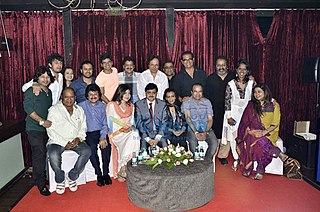Bhaṅgṛā is a type of upbeat popular music associated with the Punjab region in the northern part of the Indian subcontinent, and the Punjabi diaspora in Europe and North America.

Hindi cinema, often known as Bollywood and formerly as Bombay cinema, is the Indian Hindi-language film industry based in Mumbai. The term is a portmanteau of "Bombay" and "Hollywood". The industry is related to Cinema of South India and other Indian film industries, making up Indian Cinema—the world's largest by number of feature films produced.

The music of India includes multiple varieties of classical music, folk music, filmi, Indian rock, and Indian pop. Indian pop and Indian rock are derived from western rock and roll. India's classical music tradition, including Hindustani music and Carnatic, has a history spanning millennia and developed over several areas. Music in India began as an integral part of socio-religious life.

Dhol can refer to any one of a number of similar types of double-headed drum widely used, with regional variations, throughout the Indian subcontinent. Its range of distribution in India, Bangladesh and Pakistan primarily includes northern areas such as the Punjab, Haryana, Delhi, Kashmir, Sindh, Assam Valley, Gujarat, Maharashtra, Konkan, Goa, Karnataka, Rajasthan and Uttar Pradesh. The range stretches westward as far as eastern Afghanistan. A related instrument is the dholak or dholki.

Rajinder Singh Rai, better known by his stage name Panjabi MC, is a British recording artist, rapper, producer and DJ of Punjabi ethnicity. He is best known for the worldwide bhangra hit, "Mundian To Bach Ke" of 1997, which sold 10 million copies worldwide, making it one of the best-selling singles of all time. Among other songs, he gained acclaim with the 2003 release "Jogi". Allmusic has called him "one of the most prominent names in bhangra".

Music of Punjab reflects the traditions of the Punjab region of the Indian subcontinent, currently divided into two parts: East Punjab (India) and West Punjab (Pakistan). The Punjab has diverse styles of music, ranging from folk and Sufi to classical, notably the Patiala gharana.

Dance in India comprises numerous styles of dances, generally classified as classical or folk. As with other aspects of Indian culture, different forms of dances originated in different parts of India, developed according to the local traditions and also imbibed elements from other parts of the country.
Asian Underground is a term associated with various British Asian and South Asian Canadian musicians who blend elements of Western underground dance music and the traditional Asian music of their home countries in South Asia. The first well-known mention was the compilation album Anokha - Soundz of the Asian Underground released in 1997 and masterminded by Talvin Singh and Sweety Kapoor. It is not a strict musical genre per se, since the specific sounds can vary wildly. Most of these artists are the children or grandchildren of immigrants and have grown up in Western culture, but still have a strong Asian background through their families.
In Indian cinema, an item number or item song is a musical number inserted into a film that does not have any relevance to the plot. The term is commonly used within Indian films to describe a catchy, upbeat, often sexually provocative dance sequence for a song in a movie. The main aim of an item number is to entertain movie-goers and to lend support to the marketability of the film by being featured in trailers. They are favoured by filmmakers as they afford the opportunity pick potential hit songs from the stocks, since they do not add to the continuity of the plot. It is thus a vehicle for commercial success that ensures repeat viewing.

Stepping or step-dancing is a form of percussive dance in which the participant's entire body is used as an instrument to produce complex rhythms and sounds through a mixture of footsteps, spoken word, and hand claps. Though stepping may be performed by an individual, it is generally performed by groups of three or more, often in arrangements that resemble military formations.

Lavani is a genre of music popular in Maharashtra, India. Lavani is a combination of traditional song and dance, which particularly performed to the beats of Dholki, a percussion instrument. Lavani is noted for its powerful rhythm. Lavani has contributed substantially to the development of Marathi folk theatre. In Maharashtra and southern Madhya Pradesh, it is performed by the female performers wearing nine-yard long sarees. The songs are sung in a quick tempo.

Indian folk music is diverse because of India's vast cultural diversity. It has many forms including bhangra, lavani, dandiya, Sufi folk rock, and Rajasthani.

The 2008 Commonwealth Youth Games were held in Pune, India, a city in the state of Maharashtra. They were the third Commonwealth Youth Games, which are held every four years; they were the first Commonwealth Youth Games to be held in Asia.

Bollywood songs, more formally known as Hindi film songs or filmi songs, are songs featured in Bollywood films. Derived from the song-and-dance routines common in Indian films, Bollywood songs, along with dance, are a characteristic motif of Hindi cinema which gives it enduring popular appeal, cultural value and context. Hindi film songs form a predominant component of Indian pop music, and derive their inspiration from both classical and modern sources. Hindi film songs are now firmly embedded in North India's popular culture and routinely encountered in North India in marketplaces, shops, during bus and train journeys and numerous other situations. Though Hindi films routinely contain many songs and some dance routines, they are not musicals in the Western theatrical sense; the music-song-dance aspect is an integral feature of the genre akin to plot, dialogue and other parameters.
Tamasha is a traditional form of Marathi theatre, often with singing and dancing, widely performed by local or travelling theatre groups within the state of Maharashtra, India. It has also been the subject of several Marathi films. Some Hindi movies have also included Tamasha-themed songs, known as Lavanis, in the past.
Mujra is a dance performance by females in a format that emerged in South Asia during the Mughal empire, where the elite class and local rulers like the nawabs of the Indian society used to frequent courtesans for their entertainment at night. This trend was increasingly evident during the decadent or decline years of the Mughal empire. Many of them do mujra for entertainment.

Kaba Modern is a dance group originating from Irvine, California. Kaba Modern is a spin-off of the University of California, Irvine Filipino cultural club, Kababayan, which means "countrymen" in Tagalog. Created by Arnel Calvario in 1992, Kaba Modern began as dancers that performed the hip-hop portion or the "Modern Suite" of Kababayan's annual Pilipino Cultural Night (PCN) at UCI. Since then, Kaba Modern has entered multinational competitions and gained recognition in the media. For instance, few Kaba Modern members helped choreograph the "dance battle" scene in The Debut in 1997 while three members were shown onscreen during the Making of Featurette of the DVD.

Bhaṅgṛā is a type of traditional dance of the Indian subcontinent, originating in the Majha area of Punjab. The dance was associated primarily with the spring harvest festival Vaisakhi, and it is from one of the major products of the harvest—bhang (hemp)—that bhangra drew its name. In a typical performance, several dancers executed vigorous kicks, leaps, and bends of the body to the accompaniment of short songs called boliyan and, most significantly, to the beat of a dhol. Struck with a heavy beater on one end and with a lighter stick on the other, the dhol imbued the music with a syncopated, swinging rhythmic character that has generally remained the hallmark of any music that has come to bear the bhangra name. For the Punjabi-Sikh community in particular, every celebration continues the traditional dance form today, which is rooted at the community's core.
Bhoomi Trivedi is an Indian singer, known for her Bollywood songs "Ram Chahe Leela" from Goliyon Ki Raasleela: Ram-Leela (2013),and Husn Parcham from Zero (2018) which resulted in several awards and Nominations.













